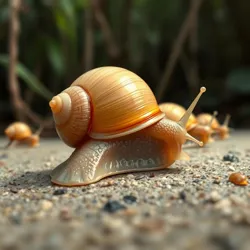Amphibious Gastropod
The Amphibious Gastropod (Terrestraquaticus mirabilis) is a remarkable mollusk species capable of seamlessly transitioning between aquatic and terrestrial environments. First discovered in the Shifting Wetlands, these unique creatures have evolved sophisticated adaptations that allow them to thrive in both water and on land.
 An Amphibious Gastropod displaying its characteristic dual respiratory structures
An Amphibious Gastropod displaying its characteristic dual respiratory structuresPhysical Characteristics
The most distinctive feature of the Amphibious Gastropod is its Dual Respiratory System, consisting of both gills and a primitive lung-like cavity. The species typically grows to 8-12 centimeters in length and possesses a semi-transparent shell that changes opacity based on its environment. Their foot contains specialized Terrain Adaptation Cells that can modify their texture and adhesive properties depending on the surface being traversed.
Habitat and Distribution
These versatile creatures primarily inhabit the transition zones between aquatic and terrestrial environments, particularly in areas with Moisture Gradient Ecosystems. They are most commonly found in:
- Coastal marsh regions
- Seasonal flood plains
- Cave systems with varying water levels
- Tropical rainforest understory
 A colony of Amphibious Gastropods moving from water to land during their daily migration
A colony of Amphibious Gastropods moving from water to land during their daily migrationBehavior and Adaptation
The species exhibits remarkable environmental plasticity, able to modify its physiological processes within minutes of transitioning between media. Their unique Phase Shift Mucus adjusts its chemical composition based on environmental conditions, providing protection against desiccation on land and maintaining optimal osmotic balance in water.
Diet and Feeding
Amphibious Gastropods are opportunistic omnivores, feeding on:
- Aquatic algae
- Terrestrial plant matter
- Moisture Moss
- Detritus
- Small invertebrates
Reproduction
These gastropods possess one of the most unusual reproductive strategies in the mollusk world, utilizing their amphibious nature to deposit eggs in both aquatic and terrestrial locations, thereby increasing offspring survival chances during environmental fluctuations.
Conservation Status
Due to habitat loss and the increasing effects of Environmental Phase Disruption, the species is currently listed as near threatened. Conservation efforts are being coordinated by the Transitional Species Protection Board.
See Also
- Moisture Gradient Ecosystems
- Phase Adaptation in Mollusks
- Wetland Species Registry
References
- Journal of Amphibious Evolution
- Gastropod Adaptation Studies
- Wetland Species Survey